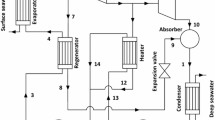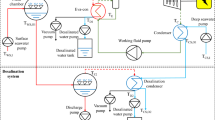Abstract
This paper presents an investigation into the thermal efficiency and main component size of the subcritical ocean thermal energy conversion (OTEC) power cycle using various working fluids under different operation conditions. The analysis procedure was performed with a simulation program written in Engineering Equation Solver. With the given analysis conditions, efficiencies of three types of working fluids were evaluated and compared. It was found that the thermal efficiencies of the subcritical OTEC power cycle depend strongly on the evaporating and condensing temperature, and turbine efficiency, while not roughly depending on superheating degrees and pump efficiencies. With a thorough grasp of these results, an efficient OTEC power cycle can be designed. R717 and R404A yielded the highest and lowest thermal efficiencies among the wet fluids, and R22 showed the largest efficiency among the dry fluids. For the iso-entropic fluids, R245fa provided the highest thermal efficiency. In comparison of main component sizes, R404A and R744 had the largest and smallest condenser size, respectively. Also, R744 exhibited the smallest evaporator size, and R404A and R227ea show the largest size. And R744 and R245fa gave the largest and smallest pump size, respectively. From the results of thermal efficiency and main components for various working fluids in the OTEC power cycle, R717 in the subcritical OTEC power cycle is the preferred working fluid, except for its toxicity and flammability.










Similar content being viewed by others
Abbreviations
- A:
-
Average (–)
- cp :
-
Specific heat at constant pressure [J/(kg K)]
- h:
-
Specific enthalpy (kJ/kg)
- \(\Delta {\text{H}}({\text{T}}_{{{\text{t}},{\text{in}}}} )\) :
-
Specific enthalpy difference related to Eq. (1)
- \({\text{Ja(T}}_{\text{t,in}} )\) :
-
Jakob number defined as \({{{\text{c}}_{\text{p}} {\text{T}}_{\text{t,in}} } \mathord{\left/ {\vphantom {{{\text{c}}_{\text{p}} {\text{T}}_{\text{t,in}} } {{\text{h}}_{\text{lv}} ( {\text{T}}_{\text{t,in}} )}}} \right. \kern-0pt} {{\text{h}}_{\text{lv}} ( {\text{T}}_{\text{t,in}} )}}\)
- L:
-
Liquid (–)
- m:
-
Mass flow rate (kg/s)
- M:
-
Molecular weight (g/mol)
- OTEC:
-
Ocean thermal energy conversion (–)
- P:
-
Pressure (kPa, MPa)
- Q:
-
Heat capacity (kW)
- T:
-
Temperature (°C, K)
- V:
-
Vapor (–)
- VER:
-
Vapor expansion ratio (–)
- W:
-
Power, work (kW)
- \(\upeta\) :
-
Efficiency (–)
- \(\Delta\) :
-
Difference (–)
- \(\Delta\)h:
-
Latent heat (kJ/kg)
- bp:
-
Normal boiling point
- c:
-
Condenser, condensing
- car:
-
Carnot
- crit:
-
Critical
- ds:
-
Deep seawater
- e:
-
Evaporator, evaporating
- in:
-
Inlet
- lv:
-
Related to latent heat of evaporation
- OTEC:
-
Ocean thermal energy conversion
- p:
-
Pump
- re:
-
Refrigerant
- ss:
-
Surface seawater
- suc:
-
Subcooling degree
- suh:
-
Superheating degree
- t:
-
Turbine
References
Yoon JI, Son CH, Baek SM, Kim HJ, Lee HS (2012) Performance characteristics of R744 OTEC power cycle with operation parameters. J Korea Soc Mar Eng 36:580–585
Yoon JI, Son CH, Baek SM (2012) Power system for ocean thermal energy conversion (OTEC). J Korea Soc Mar Eng 36:217–223
Bruch L (1994) Vicki, an assessment of research and development leadership in ocean energy technologies, SAND93-3946. Sandia National Laboratories, Albuquerque
U.S. Energy Information Administration (2014) Average retail price of electricity to ultimate customers by end-use sector. U.S. Department of Energy, Washington
Son CH, Lee DG, Oh HK, Kim YL (2004) The heat transfer and pressure drop characteristics of CO2 during supercritical region in a horizontal tube. J Korea Soc Mar Eng 28:500–508
Uehara H, Miyara A, Ikegami Y, Nakaoka T (1996) Performance analysis of an OTEC plant and a desalination plant using an integrated hybrid cycle. J Sol Energy Eng 118:115–122
Uehara H, Dilao CO, Nakaoka T (1998) Conceptual design of ocean thermal energy conversion power plants in the Philippines. Sol Energy 41:431–441
Yeh RH, Su TZ, Yang MS (2005) Maximum output of an OTEC power plant. Ocean Eng 32:685–700
Rabas TJ, Panchal CB, Stevens HC (1990) Integration and optimization of the gas removal system for hybrid-cycle OTEC power plants. J Sol Energy Eng 112:19–28
Tseng CH, Kao KY, Yang JC (1991) Optimal design of a pilot OTEC power plant in Taiwan. J Energy Resour Technol 113:294–299
Kim NJ, Ng KC, Chun W (2009) Using the condenser effluent from a nuclear power plant for Ocean Thermal Energy Conversion (OTEC). Int Commun Heat Mass Transf 36:1008–1013
Sun F, Ikegami Y, Jia B, Arima H (2012) Optimization design and exergy analysis of organic Rankine cycle in ocean thermal energy conversion. Appl Ocean Res 35:38–46
Shengjun Z, Huaixin W, Tao G (2011) Performance comparison and parametric optimization of subcritical organic rankine cycle (ORC) and transcritical power cycle system for low-temperature geothermal power generation. Appl Energy 88:2740–2754
Refrigerant report. BITZER, Germany, 15 edn, A-501-15 (2012)
Klein SA (2012) Engineering Equation Solver (EES), fChart Software Inc., Academic V9.172
Maizza V, Maizza A (1996) Working fluids in non-steady flows for waste energy recovery systems. Appl Therm Eng 16:579–590
Chen H, Yogi Goswami D, Stefanakos K, Elias K (2010) A review of thermodynamic cycles and working fluids for the conversion of low-grade heat. Renew Sustain Energy Rev 14:3059–3067
Hung TC, Wang SK, Kuo CH, Pei BS, Tsai KF (2010) A study of organic working fluids on system efficiency of an ORC using low-grade energy sources. Energy 35:1403–1411
Mikielewicz ID, Mikielewicz J (2010) A thermodynamic criterion for selection of working fluid for subcritical and supercritical domestic micro CHP. Appl Therm Eng 30:2357–2362
Acknowledgments
This work was financially supported by the National R&D project of the “Development of Energy utilization technology with Deep Ocean Water” supported by the Korean Ministry of Land, Transport and Maritime Affairs.
Author information
Authors and Affiliations
Corresponding author
Rights and permissions
About this article
Cite this article
Yoon, JI., Son, CH., Baek, SM. et al. Efficiency comparison of subcritical OTEC power cycle using various working fluids. Heat Mass Transfer 50, 985–996 (2014). https://doi.org/10.1007/s00231-014-1310-8
Received:
Accepted:
Published:
Issue Date:
DOI: https://doi.org/10.1007/s00231-014-1310-8




